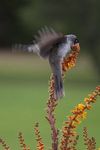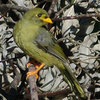Genus Manorina

Yellow-throated Miner - The Yellow-throated Miner is a medium sized bird, reaching a length of 26 to 28 centimetres . The dorsal surface is a dark grey, and the ventral surface almost white. The beak, eye skin, side of the throat, legs, feet and parts of the wing and tail are yellow. The feather surrounding the eye are black, and the rump is white.
Noisy Miner - Colouration is principally grey, with a lighter grey on their underbelly. The wings have flashes of green on the edges. The beak and area around and behind the eyes is yellow. When indicating submission, the bird frequently fluffs up the feathers around the eye, opening its beak to flutter its tongue and softly utter a "pipipipipee, pee, pee!" noise. A distinctive black head resembling a miner's cap gives rise to its name. Grows to 20–25 cm in size.
Bell Miner - Bell miners live in large, complex social groups. Within each group there are subgroups consisting of several breeding pairs, but also including a number of birds who are not currently breeding. The nonbreeders help in providing food for the young in all the nests in the subgroup, even though they are not necessarily closely related to them. The birds defend their colony area communally aggressively, excluding most other passerine species. They do this in order to protect their territory from other insect-eating birds that would eat the bell lerps on which they feed. Whenever the local forests die back due to increased lerp psyllid infestations, bell miners undergo a population boom.
Manorina melanotis - Black-eared Miners are listed as endangered on the Australian Environment Protection and Biodiversity Conservation Act 1999. Their conservation status also varies from state to state within Australia. For example:



